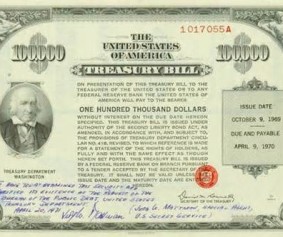Why Treasury Prices Are Rising This Year
Thursday, June 12th, 2014 @ 5:09PM
Between the Lines
by Gary D. Halbert
To the surprise of most forecasters, US long-dated Treasury prices have risen significantly this year, even as the Fed continues to wind-down its QE purchases. When Treasury prices rise, yields (interest rates) fall. The yield on 10-year Treasury notes plunged below 2.5% in May, down from a high of over 3.0% at the end of last year. So why are Treasury yields falling?
Overseas buyers, led by China, are buying US debt to accumulate dollars and help weaken their currencies as a way to boost exports. Financial institutions are stocking up in response to regulations that require them to hold extra capital. Many investors are purchasing Treasuries because they yield more than most comparable securities.
China was a net buyer of $55.8 billion in Treasury notes and bonds during the first three months of this year, according to the latest data from the Treasury’s website. Last year, China added $81.1 billion in US Treasuries.
The purchases are taking place while the supply of US government debt is shrinking, due to the ongoing economic recovery and narrower budget deficit. Strong global demand, shrinking supply and uneven economic growth have helped to limit the impact of reduced purchases by the Fed, fueling a price rally that few analysts predicted.
The most recent example of the unusual dynamics driving the $12 trillion market: Treasury prices rallied last week, sending the 10-year yield as low as 2.53%, even after the government said nonfarm payrolls expanded by a better-than-expected 217,000 in May. Normally, signs of stronger economic growth in the US push investors out of government debt, driving prices lower. Not so far this year.
The shift is the latest twist in the global search for assets that offer an attractive balance of income and safety, amid low interest rates, easy-money policies by central banks and sluggish economic growth.
“Treasury bonds are a bargain, actually,” compared with lower-yielding German government bonds, said Christopher Sullivan, who oversees $2.3 billion as chief investment officer at the United Nations Federal Credit Union.
Many analysts said recently that the appeal of Treasuries stems in large measure from the superior yields they offer compared with other developed nations’ government debt. Japanese 10-year government bonds yielded 0.6% last week, while comparable German bunds yielded 1.31%. Meanwhile, US economic fundamentals are broadly considered rosier than those in Europe and Japan.
The 10-year Treasury yield also is just below those offered by economically weaker Western countries such as Spain and Italy. Last week, the 10-year government bond yielded 2.65% in Spain and 2.77% in Italy.
The US isn’t expected to issue as much debt as in previous years because of higher tax receipts expected this year. The Congressional Budget Office said in April that the US budget deficit for this fiscal year will be only $492 billion, marking the smallest deficit since 2007.
This year as the Fed has been dialing back its monthly QE purchases, more new Treasury bonds are available to other investors compared with last year. Yet unlike last year, when many investors globally shed holdings of US Treasuries, investors this year have piled into this debt. So even as the Fed has been cutting its buying, investors are competing over a net supply of bonds that is actually much smaller than at the peak in 2010.
In the 1Q, Treasury holdings at US commercial banks and savings institutions rose to $237.2 billion, the highest since 1995, according to data from the FDIC. Traders and analysts said the purchases have been driven in part by capital and liquidity requirements that put a premium on safe, easily tradable securities such as Treasuries.
US bond mutual funds and exchange-traded funds (ETFs) attracted $21.7 billion in new cash in May alone, bringing the inflow this year to $64.6 billion, according to fund tracker TrimTabs Investment Research. Last year, on the other hand, US bond mutual funds and ETFs experienced a $77.8 billion outflow, the biggest in a calendar year since recordkeeping started in 1984.
To be sure, many forecasters still believe 10-year Treasury yields will exceed 3% this year, especially if the economy picks up in the second half, a development that would punish recent buyers at higher prices.
And let’s not forget that the Fed intends to halt its QE bond buying program by the end of September or October. Currently, the Fed is buying $20 billion per month of long-dated Treasuries, but that will likely be cut to $15 billion at the policy meeting next week on June 17-18.
For all the reasons noted above, the second half of the year could be a rough ride for longer maturity Treasuries.
Posted by AIA Research & Editorial Staff
Categories: Between the Lines




